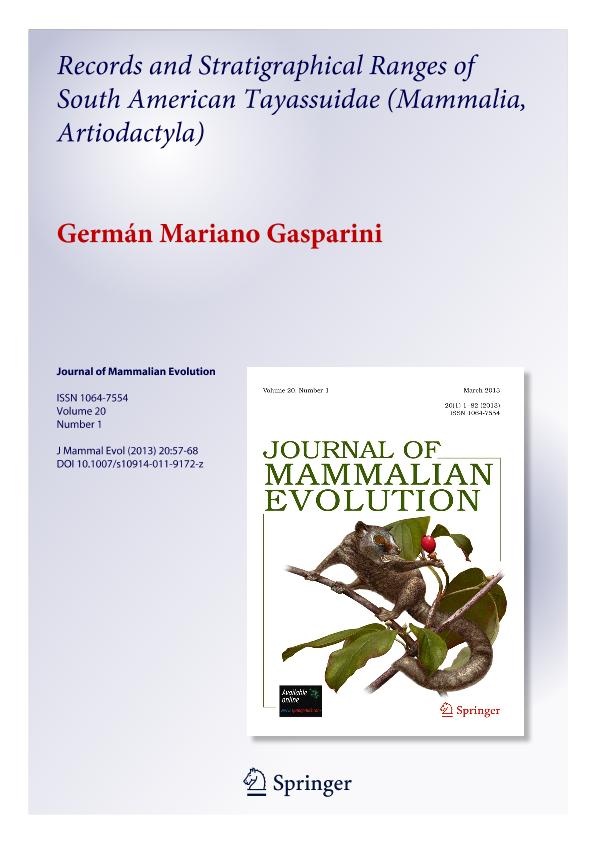Mostrar el registro sencillo del ítem
dc.contributor.author
Gasparini, Germán Mariano

dc.date.available
2017-08-11T19:20:50Z
dc.date.issued
2013-03
dc.identifier.citation
Gasparini, Germán Mariano; Records and stratigraphical ranges of South American Tayassuidae (Mammalia, Artiodactyla).; Springer; Journal of Mammalian Evolution; 20; 1; 3-2013; 57-68
dc.identifier.issn
1064-7554
dc.identifier.uri
http://hdl.handle.net/11336/22239
dc.description.abstract
Tayassuidae represent one of the first mammalian immigrants that entered South America during the “Great American Biotic Interchange.” However, the exact moment of its arrival for the first time in South America is controversial. Three genera are recognized in South America: Platygonus, Catagonus, and Tayassu. This paper aims to: (1) review the paleontological record of the South American Tayassuidae and update it; and (2) discuss its geographical and statigraphical distribution pattern in South America. The genus Platygonus (middle Pliocene to early Pleistocene) is registered in Argentina, Uruguay, Colombia, and Bolivia; Catagonus (late Pliocene? to Recent) in Argentina, Uruguay, Brazil, and Bolivia; and Tayassu (middle Pleistocene to Recent) in Argentina, Uruguay, and Brazil. Platygonus and Catagonus have adaptations to dry and relatively open environments; in contrast, Tayassu is adapted mainly to humid climates and woodland and forest environments. The faunal changes that took place since the middle-late Pliocene could have been strongly influenced by climate. Open and arid environments developed during the glacial cycles, allowing the latitudinal expansion of Platygonus and Catagonus. Considering ecological and anatomical information, it is possible to infer that Platygonus species were replaced by those of Catagonus since the middle Pleistocene, probably due to a reduction of the open environments to which Platygonus species were better adapted. The alternation of these mainly arid or semiarid, cold conditions with warmer and more humid short pulses would have allowed the posterior expansion of Tayassu species. According to phylogenetic analysis and chronological as well as geographical evidence, Platygonus and Catagonus represent two Tayassuidae lineages that originated in North America and then migrated to South America. This migration would have occurred on more than one occasion and with different taxa. Evidence indicates that Tayassu represents a lineage that differentiated in the Southern Hemisphere and then migrated to North America.
dc.format
application/pdf
dc.language.iso
eng
dc.publisher
Springer

dc.rights
info:eu-repo/semantics/openAccess
dc.rights.uri
https://creativecommons.org/licenses/by-nc-sa/2.5/ar/
dc.subject
Peccaries
dc.subject
Great American Biotic Interchange
dc.subject
Platygonus
dc.subject
Catagonus
dc.subject
Tayassu
dc.subject
Pliocene
dc.subject
Pleistocene
dc.subject
Holocene
dc.subject
Paleobiogeography Range
dc.subject.classification
Oceanografía, Hidrología, Recursos Hídricos

dc.subject.classification
Ciencias de la Tierra y relacionadas con el Medio Ambiente

dc.subject.classification
CIENCIAS NATURALES Y EXACTAS

dc.title
Records and stratigraphical ranges of South American Tayassuidae (Mammalia, Artiodactyla).
dc.type
info:eu-repo/semantics/article
dc.type
info:ar-repo/semantics/artículo
dc.type
info:eu-repo/semantics/publishedVersion
dc.date.updated
2017-08-07T16:38:05Z
dc.identifier.eissn
1573-7055
dc.journal.volume
20
dc.journal.number
1
dc.journal.pagination
57-68
dc.journal.pais
Estados Unidos

dc.journal.ciudad
Nueva York
dc.description.fil
Fil: Gasparini, Germán Mariano. Universidad Nacional de la Plata. Facultad de Ciencias Naturales y Museo. División Paleontología Vertebrados; Argentina. Consejo Nacional de Investigaciones Científicas y Técnicas; Argentina
dc.journal.title
Journal of Mammalian Evolution

dc.relation.alternativeid
info:eu-repo/semantics/altIdentifier/doi/http://dx.doi.org/10.1007/s10914-011-9172-z
dc.relation.alternativeid
info:eu-repo/semantics/altIdentifier/url/https://link.springer.com/article/10.1007%2Fs10914-011-9172-z
Archivos asociados
